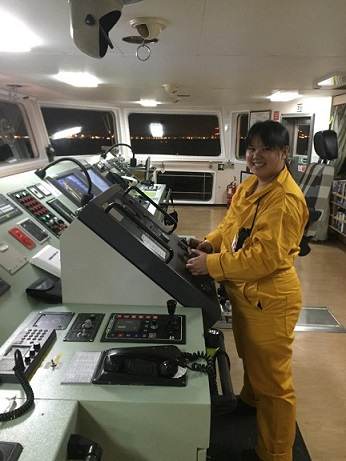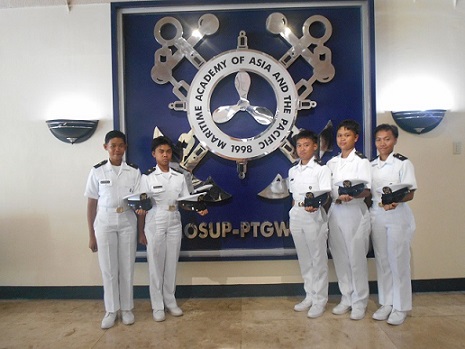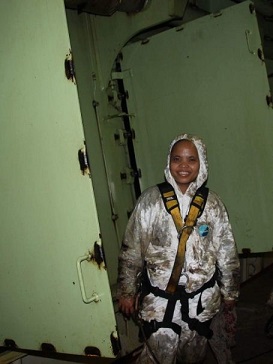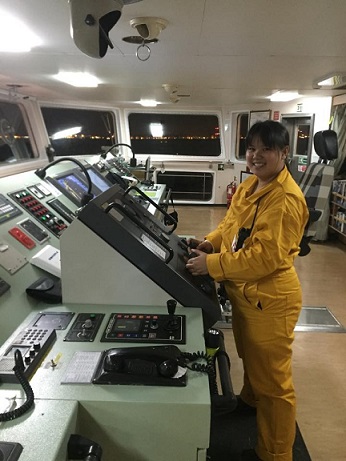
BY LUCIA P. TANGI
ONE day at sea, Filipina Marine Engineer Monique Arrojado found herself alone with the Danish captain of an international cargo vessel she was deployed to.
“There is something in you. I really like you,” the captain bluntly told Arrojado, then 22 and a fourth engineer, in his office.
Arrojado was offended. The captain was already married.
“Sir, I came on board to work and not to look for a boyfriend,” she shot back.
Despite the rebuff, her boss would persist in inviting Arrojado to his office, and it took her every means to make sure she would never be alone again with him.
For female seafarers, sexual harassment on the high seas is just one, but an all-too-real layer in the glass ceiling they bump into in this male-dominated profession. More so for women officers on board international vessels who find their climb to the top strewn with requests of sexual favors from superiors.
But in their midst, too, count Filipino women officers like Arrojado, now 26 and a third engineer, who dare challenge sexist beliefs and gender stereotypes in the seafaring industry.
Opening up
The Philippines started deploying women marine deck officers and marine engineerson board international vessels in the late 1990s, sending 1,404 of them from 2011 to 2014, according to data from the Philippine Overseas Employment Administration.
Although less than 1 percent of the total sea officers sent over the period, the figure represents a big stride for gender equality and women empowerment.
The government-funded Philippine Merchant Marine Academy (PMMA), the oldest maritime school in the country, opened its doors to women cadets only in 1993, some 173 years after the academy was founded.
It was the first to do so, following the passage in 1992 of Republic Act 7192 or the Women in Development (WID) and Nation Building Act mandating the integration of women in various industries and in the military to make them full and equal partners of men in development and nation building.
Most of PMMA graduates are now officers in the seafaring industry, Philippine Coast Guard and the Philippine Navy.
MAAP, owned and operated by the Associated Marine Officers and Seafarers Union of the Philippines (AMOSUP), would follow suit in 1998.
Today, most of the women marine officers come, too, from the John B. Lacson Maritime University in Iloilo City, Lyceum of the Philippines–Batangas Campus and the Palompon Institute of Technology in Leyte.

Not quite one of the boys
Equipped with the same knowledge and skills as men, female marine officers like Arrojado, forget about fashion and make-up and wear uniforms “like one of the boys.” They perform all duties that their male colleagues do, including dropping the heavy anchor chain, carrying heavy load and mixing chemicals to prevent ship pipes from rusting.
But it is not the work load or the dirty jobs on board that have been turning away women officers from working on board. Dealing with sexist men and working with people from different cultures are the biggest challenges that they have to brace with.
Almost always, they are still considered as “pambahay” or good for the home. Those who dare defy or challenge such sexist views are often discriminated and isolated by male seafarers.
Licensed Captain Ma. Kristina Javellana said when she was just starting out, she was discouraged by male seafarers from boarding a chemical tanker. “Baka naman pagsayawin ka lang doon, sabi nila sa akin (They’ll probably just make you dance, they told me).”
Javellana, however, ignored the “advice” of male seafarers and mentors and joined Stolt Nielsen Transportation Group which deploys chemical, gas and oil tankers worldwide.
“Gusto chemical tanker, kasi mas delikado mas mataas ang stantard of safety. I find it interesting. Wala pa kasi babae nakapenetrate doon (I prefer a chemical tanker because it’s more exciting and interesting. The safety standards also higher. And no female has penetrated that area),” she said.
Second Engineer Luzviminda Ornopia, a graduate of Palompon Institute of Technology, remembers how the Indians and Ukrainians she works with would use to taunt her, saying women were only good for house chores and taking care of babies.
“You will get offended at first of course, but in the long run I learned how to defend myself and to speak out. Then they slowed down and stopped discriminating me,” she said.
Indeed, as Nina Sue Da Silva, the country’s first woman licensed chief engineer and a graduate of MAAP, found out: “Lahat po ng trabaho sa barko especially sa engine mahirap po. (Pero) mas mahirap ang pakikitungo sa ibat ibang tao (All the jobs on board, especially in the engine department, are difficult. But dealing with people is the most difficult part (of seafaring).”
Because of their sexist views, male officers tend to underestimate the women’s skills and capability.
Ornopia said some women marine engineers are barred from performing their tasks, and assigned to do paper works instead of dealing directly with the ship engine.
It was the other way around for Arrojado. Besides the Danish captain, the Indian chief engineer on her vessel made her life on board miserable. “He did not allow other male seafarers to help me, and he gave me heavy workload. He did not give me a good evaluation report,” she said.

Sexual harassment on board
All the 10 women officers interviewed for this report said they have experienced various forms of sexual harassment. Most incidents happened when they were junior officers.
Sexual harassment usually comes in the form of sexist comments, invitation in the cabin and offer of paid sex.
Like Arrojado, Da Silva was a fourth engineer when the Danish chief mate made an indecent proposal.
“Akala nya nagpapabayad ako (He thought that I was offering sex for cash),” she said.
It turned out that the veseel used to have a Filipina steward who was peddling sexual services. “Akala ng Danish na yon na lahat ng Pinay ganon (This Danish thought that all Filipino women are the same),” she said.
Da Silva confronted the Danish chief mate. She also reported the incident to the captain, and an investigation ensued.
An Indian second engineer would likewise prey on Da Silva when she was a third engineer and up for promotion as second engineer.
She recalled that the Indian used to give her a light workload inside the control room.
One day, he invited Da Silva to watch television inside his cabin. She turned down the invitation and told the Indian: “Binanantan ko na sya na if you think kung saan mapupunta tong balak mo, di ka uubra sakin (I warned him he would get nowhere with me).”
After the incident, the Indian second engineer started giving Da Silva a heavy workload and often reprimanded her for no valid reason. He also wrote bad remarks on the evaluation form of Da Silva. “Akala nya po magmamakaawa ako sa promotion (He thought I’dbeg for help so I’d get promoted),” she said.
Da Silva reported the incident to the chief engineer, and the company disregarded the negative evaluation of her performance. She was eventually promoted to second engineer.
Unlike Da Silva, Arrojado felt she had no one to run to.
As a rule, seafarers are advised to report any incident or problems at work to their superior. So to whom should one report a sexual harassment if the perpetrator were the ship captain?
To eliminate sexual harassment on board, Javellana suggested the adoption of an industry-wide anti-sexual harassment policy must be introduced.
But she said an immediate measure would be to ensure at least two women working on board. Usually, there is only one female out of a 24-man crew in a merchant vessel.
If there were two of them, “you have someone to talk to and who can relate with you. The focus of men is not concentrated on you,” Javellana said.
(The author is a journalism professor at the University of the Philippines-Diliman. She interviewed the women officers as part of her policy research, “Empowering Filipino Women Seafarers,” funded under the University of the Philippines President Edgardo J. Angara Fellowship Award. The study is scheduled to be released in June.)
